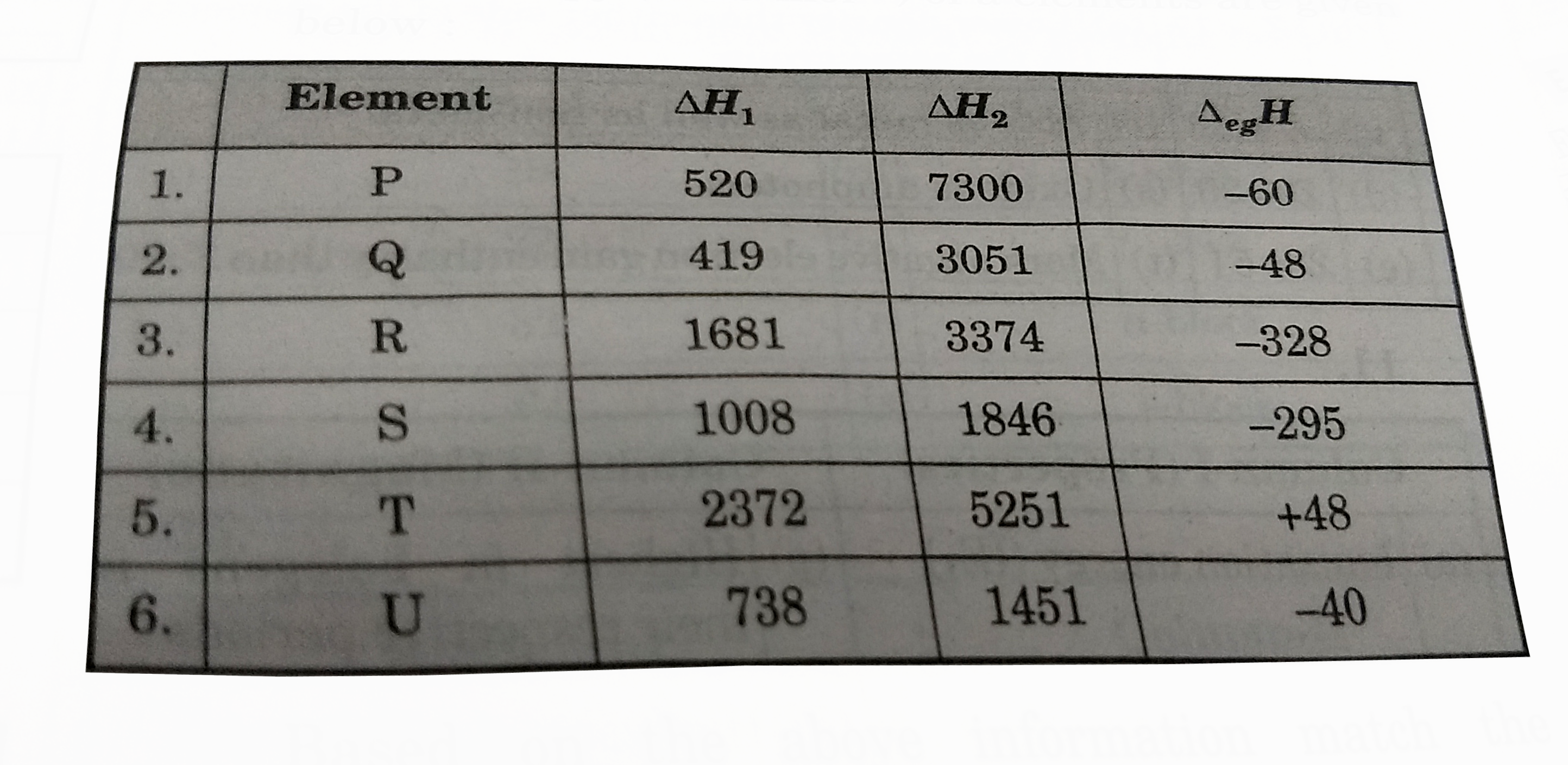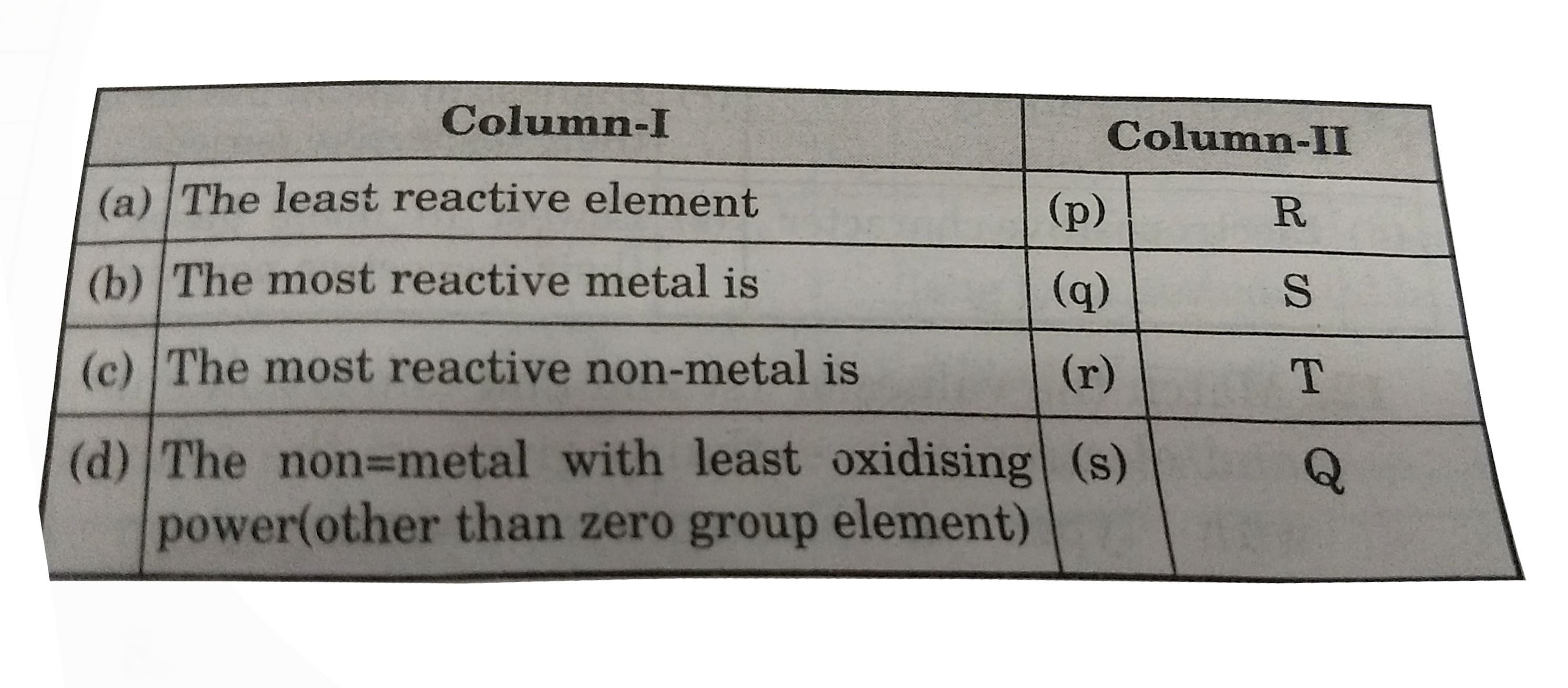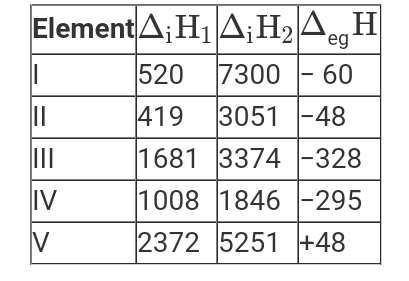The first (ΔiH1) and second (ΔiH2) ionisation enthalpies (inkJmol−1) and the (ΔegHө) electron gain enthalpy (inkJmol−1) of a few elements are given below:
Elements(ΔiH1)(ΔiH2)ΔegHөI5207300−60II4193051−48III16813374−328IV10081846−295V23725251+48VI7381451−40
Which of the above elements is likely to be
a. the least reactive element.
b. the most reactive metal.
c. the most reactive non-metal.
d. the least reactive non-metal.
e. the metal which can form a stable binary halide of the formula MX (X=halogen).
f. the metal which can form a predominantly stable covalent halide of the formula MX(X=halogen).
a. The element V which has the highest IE1 and positive. (ΔeqHө) is the least reactive elements. Since inert gases have positive (ΔeqHө) , therefore, the element V must be an inert gas. The values of IE1,IE2 and (ΔeqHө) match that of helium (He).
b. The element II which has the least IE1 and a low negaive (ΔeqHө) is the recative metal. The values of IE1,IE2 and (ΔeqHө) match that of K (potassium).
c. The element III which has high IE1 and a very high negative (ΔeqHө) is the recative non-metal. The values of IE1,IE2 and (ΔeqH) match that of F (fluorine).
d. The element IV has a high negative (ΔeqHө) but not so high IE1 . Therefore, it is the least reactive non-metal. The values of IE1,IE2 and (ΔeqHө) match that of I (Iodine).
e. The element VI has low IE1 but higher than that of alkali metals. Therefore, it appears that the element is an alkaline earth metal and hence will form binary halide of the formula MX2(where X=halogen). The values of IE1,IE2 and (ΔeqHө) match that of Mg (magnesium).
f. The element I has low IE1 but a very high IE2, therefore, it must be an alkali metal. Since the metal forms a predominantly stable covalent halide of the formula MX(X=halogen), therefore ,the alkali metal must be least reactive. The values of IE1,IE2 and (ΔeqHө) match that of Li (llithium).
Topper's Solved these Questions
- BOOK - CENGAGE CHEMISTRYCHAPTER - APPENDIX - INORGANIC VOLUME 1EXERCISE - Exercise very short70videos
APPENDIX - INORGANIC VOLUME 1
- BOOK - CENGAGE CHEMISTRYCHAPTER - APPENDIX - INORGANIC VOLUME 1EXERCISE - Exercise Short146videos
APPENDIX - INORGANIC VOLUME 1
- BOOK - CENGAGE CHEMISTRYCHAPTER - ALKYNESEXERCISE - Exercises (Archives - Analytical and Desriptive Type)4videos
ALKYNES
- BOOK - CENGAGE CHEMISTRYCHAPTER - ATOMIC STRUCTUREEXERCISE - Concept Applicationexercise(4.3)19videos
ATOMIC STRUCTURE
Similar Questions
The first (ΔiH1) and second (ΔiH2) ionisation enthalpies (inkJmol−1) and the (ΔegHө) electron gain enthalpy (inkJmol−1) of a few elements are given below:
Elements(ΔiH1)(ΔiH2)ΔegHөI5207300−60II4193051−48III16813374−328IV10081846−295V23725251+48VI7381451−40
Which of the above elements is likely to be
a. the least reactive element.
b. the most reactive metal.
c. the most reactive non-metal.
d. the least reactive non-metal.
e. the metal which can form a stable binary halide of the formula MX2 (X=halogen).
f. the metal which can form a predominantly stable covalent halide of the formula MX(X=halogen).View SolutionThe first (ΔH1) and second (ΔH2) ionisation enthalpies (in kJmol−1) and the (ΔHeg) electron gain enthalpy (in kJmol−1) of a elements are given below:

Based on the above information match the following columns.
 View Solution
View Solution
Knowledge Check
- Question 1 - Select One
The first (ΔIH1) and second (ΔIH2) ionisation enthalpies (in kJ mol−1) and the (ΔegH) electron gain enthalpy (in kJ mol−1) of a few elements are given below:

The least reactive element is :APBQCRDT - Question 2 - Select One
The first (ΔiH1 and second (ΔiH2 ionization enthalpies (in kJ/mol) and electron gain enthalpy (in kJ/mol) of few elements are given below:
ElementsΔiH1ΔiH2ΔegHI5207300−60II16813374−328III8991757+48IV23725251+48
Which of the above is likely to be He:AIBIICIIIDIV - Question 3 - Select One
The first (ΔiH1 and second (ΔiH2 ionization enthalpies (in kJ/mol) and electron gain enthalpy (in kJ/mol) of few elements are given below:
ElementsΔiH1ΔiH2ΔegHI5207300−60II16813374−328III8991757+48IV23725251+48
Which of the following is likely to be an alkali metal?AIBIICIIIDIV
The first (IE1) and second (IE2) ionisation energies (kJmol−1) of a new element designated by roman numericals are shown below:
(IE1)(IE2)I23725251II5207300III9001760IV16803380
Which of these elements is likely to be (a) a reactive metal, (b) a reactive non-metal, (c) a noble gas and (d) a metal that forms a binary halide of the formula, AX2.View SolutionThe first (IE1) and the second (IE2) ionization enthalpies (kJ mol−1) of a few elements designated by Roman numerals are shown below:
ElementIE1IE2I23725251II5207300III9001760III9001760IV16803380
Which of the above elements is likely to be a,
reactive non metalView SolutionThe first (IE1) and the second (IE2) ionization enthalpies (kJ mol−1) of a few elements designated by Roman numerals are shown below:
ElementIE1IE2I23725251II5207300III9001760III9001760IV16803380
Which of the above elements is likely to be a,
reactive non metalView SolutionThe first (IE1) and the second (IE2) ionization enthalpies (kJ mol−1) of a few elements designated by Roman numerals are shown below:
ElementIE1IE2I23725251II5207300III9001760III9001760IV16803380
Which of the above elements is likely to be a,
reactive metalView SolutionThe first (ΔiH1) and second (ΔiH2) ionization enthalpies (in kJ mol−1) and the electron gain enthalpy (ΔegH)(in kJ mol−1) of the elements I, II, III, IV and V are given below

the least reactive non - metal and the most reactive metal of these are respectivelyView Solution

